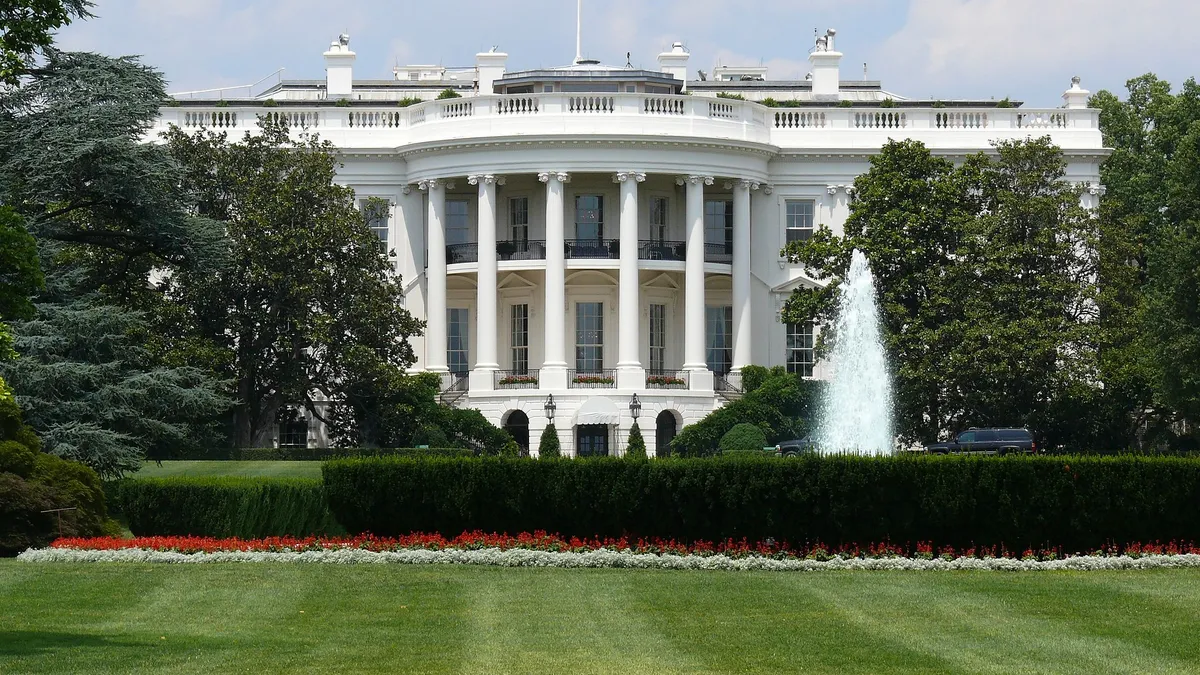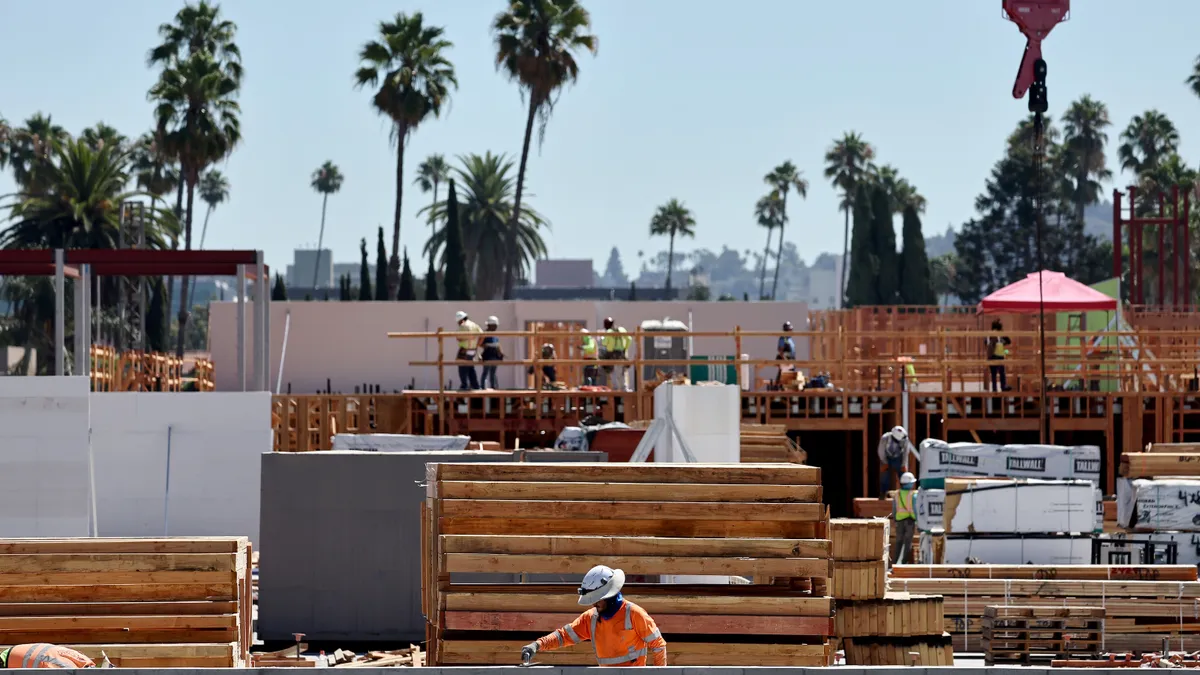With the dust settling on one of the most bitterly fought presidential campaigns in recent memory, homebuilders are now assessing what a Trump presidency means for the industry and whether he will deliver on his campaign pledges.
Although Trump positioned himself before the building industry as a fellow builder and developer, it remains to be seen just how he will treat those proposals once in office. Initial feedback from the residential construction sector suggests that its members are largely hopeful for the candidate that touted himself as a fellow builder and developer.
"Our membership felt very strongly that Donald Trump was going to win," Jim Tobin, chief lobbyist at the National Association of Home Builders in Washington, DC, told Construction Dive last month. "Talking to a lot of them across the country over the last months, his message was resonating outside the Beltway."
As the industry contends with rising prices, limited inventory, a tough regulatory environment and a shortage of qualified labor — much of which Trump addressed, albeit in somewhat vague terms, and pledged to combat in the lead-up to the election — we checked in with builders and analysts to gauge their expectations for the incoming administration.
Initial response
There is a sense that the Trump victory could instigate a short-term psychological impact on consumers rather than an economic one, with homebuyer confidence boosted in some of the economically static “red” states. But buyers in the “blue” states, which have a more positive economic outlook, could be hesitant and anxious, said Oren Jacobson, lead market analyst at national real estate sales management firm New Home Star.
During his campaign, Trump emphasized his own exasperation at the regulatory burden that builders face and the impact on project costs, which market participants often blame for sluggish inventory volumes.
A report released by the NAHB in May found that local, state and federal regulatory costs make up, on average, 24.3% of a home’s final selling price and that the dollar value of those costs has jumped 30% from 2011 to 2016. Those costs include impact fees, utility hookups, building permits, implementing worker safety regulations and delay-related interest payments.
“There will be an opportunity for relief in a number of areas, at least the rate of tightening or the expansion of the regulatory regimen in lots of different ways that have had an impact on pushing affordability or creating affordability challenges and, frankly, restricting the supply side, which obviously contributes to affordability,” Beazer Homes CEO Allan Merrill said on a conference call in mid-November. “We are likely to see, over the next couple of years, some change in the direction of that regulatory environment. And I think that may be positive.”
The NAHB has said it will work with the incoming administration on what it sees as an overbearing regulatory environment, addressing areas like the Waters of the U.S. Rule, under the Clean Water Act, which impacts costs to build. It is also looking at the Occupational Safety and Health Administration’s confined spaces rule and silica dust standards.
“It’s death by a thousand cuts to this industry,” said NAHB CEO Jerry Howard, adding that easing restrictions on the construction process will yield lower costs and go some way to helping bridge the gap of affordably priced homes in the marketplace.
An uncertain regulatory future
While any regulatory reforms at the federal level would be broadly welcomed by the industry, there are other areas of concern for smaller homebuilders.
Marilyn Perez, design director at Homeworks, a custom homebuilder in Tampa, FL, said that smaller builders are more likely impacted by local rules and regulations than federal and state ones.
“There are regulations we obviously have to deal with like FEMA [Federal Emergency Management Agency] and height restrictions on homes near airports by the FAA [Federal Aviation Administration],” she said. “But a lot of the regulations we face are more localized and driven mainly by the city, so I am not sure how much of an impact the Trump administration will have in relation to our day-to-day business.”
Tax reform could also act as a stimulus for the housing industry, with Trump saying he plans to reduce the number of income brackets, cut the corporate tax rate from 35% to 15% and eliminate the corporate alternative minimum tax. Additionally, he has said he will cut rates for pass-through entities — a classification that many homebuilding companies utilize.
Still, it is early in the transition process and there are questions as to whether Trump, even with a Republican majority in Congress, can push through sweeping tax reform.
New Star’s Jacobson noted that despite tax cuts potentially putting more money in the hands of those in the upper income brackets, it may not boost demand for housing in significant numbers. “The tax break for the lower 90% of the population is also not likely to be dramatic enough to see a change in affordability,” he said.
On the campaign trail, Trump said he would look to maintain the Mortgage Interest Deduction, a measure that housing market players believe is central to making housing affordable and available. He also suggested rolling back parts of the Dodd-Frank Wall Street Reform and Consumer Protection Act. Trump has claimed that the compliance costs associated with the legislation are holding up the financing and the development of new construction and individual mortgages. It is also believed to be preventing many community banks from lending into the construction market.
“The Dodd-Frank act has particularly crippled smaller banks,” Howard said.
Howard noted that easing some of the lending restrictions on banks could also help first-time buyers gain a foothold in the property market by improving their access to credit, a buyer segment that has been a question mark for the industry in recent years. A report from the National Association of Realtors in November noted that first-time buyers are returning to the market in greater numbers recently, accounting for 35% of home sales today, up from 32% in 2015 and the highest level since 2013.
Higher interest rates, trade reform ahead
Trump, however, could be picking up the keys to the White House just as the market starts to feel the pinch from a now-expected hike in interest rates this month. Federal Reserve Chair Janet Yellen hinted in November that a rise in interest rates is likely before the end of the year. The Fed last raised its benchmark rate in December 2015 and it currently sits in a range of 0.25% and 0.5%.
Perez noted that higher interest rates will have consequences for builders across the board, raising the cost to borrow and, ultimately, their willingness to assume risk.
“Any change in interest rates impacts us,” she said. “The cost to build becomes more expensive since it changes our buying power for both products and materials and for the purchase of properties.”
There are other areas of concern, with Trump’s transition team reportedly looking at the renegotiation of the North American Free Trade Agreement. That could favor the U.S. in areas like Canadian softwood lumber, which heads of the U.S. lumber industry believe is being dumped in the country at less than fair-market value.
“We’re aggressively exploring with the incoming administration whether we can do more domestic harvesting of lumber and looking at alternate markets like Chile to see if it can fill the vacuum,” Howard said.
In September, the NAHB held talks with public and private groups in Chile to discuss the country boosting its exports of softwood and other lumber products to the U.S. Imports from Chile currently represent a 1.22% share of the U.S. lumber market.
Trump’s tough stance on immigration could exacerbate current labor shortages, as up to 20% of construction workers are undocumented, according to recent estimates. The industry is vying to attract more skilled workers through investment in technical training and exploring new paths for non-citizen workers. Calls on the campaign trail for mass-deportation and stricter immigration policy could leave the construction industry short workers, though the Trump team seems to be cooling its rhetoric. Industry groups have come out largely in support of the H-2B visa program, guest worker programs and other paths to citizenship for workers.
While there is still plenty of debate ahead, most industry participants do seem to agree on one thing — a Trump presidency, for housing at least, will be far from dull.





















